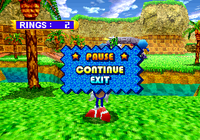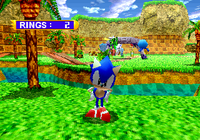Clean pause
From Sega Retro
Clean pause is the act of removing any special text or imagery that appears when a video game is paused. It is a feature used both as a debugging tool, and a means for the video game press to take accurate screenshots of a game in motion, without the game actually moving.
History
In the early days of video gaming, all "pauses" were "clean". Any implemented pause feature would literally "pause" the game from processing, the effect being a static image left on the television or computer screen until the game was unpaused. As technology progressed, developers began implementing indicators so that the user would know the game was paused so users knew what the state of the game was. With a limited number of buttons on a typical video game controller, pause screens were also been used to relay information to the player, change options and end the game.
However, the need for an "unchanged" pause screen was always a desire of both the video game press and marketing teams, which required the screen to be controlled and static in order to take aesthetically pleasing screenshots. With the only alternative to offer development builds and test hardware, many developers implemented a clean pause function to assist with these use cases. This feature often shipped with final, commercially released products, but was not typically mentioned in game manuals.
Implementations
Saturn
The Sega Saturn library has patchy support for the clean pause function, which was usually standardised as ![]() +
+![]() +
+![]() (when paused). Performing the code again usually (but not always) reverts back to the standard pause screen.
(when paused). Performing the code again usually (but not always) reverts back to the standard pause screen.
Games published by Sega are more likely to implement this feature. It is not known if the concept was relayed to third-party developers at the time.
Dreamcast
For Dreamcast games, Sega mandated that when paused, the game should show the text "PAUSED" (or something similar to that effect) to distinguish pausing from software bugs[1]. As such, no Dreamcast games should default to a clean pause.
A clean pause feature, enabled by pressing ![]() +
+![]() (when paused) was "recommended" by Sega[2] but not mandated, meaning while a significant number of games implement a clean pause feature, not all do. Similarly to the Saturn, pressing the code usually (but not always) reverts back to the standard pause screen.
(when paused) was "recommended" by Sega[2] but not mandated, meaning while a significant number of games implement a clean pause feature, not all do. Similarly to the Saturn, pressing the code usually (but not always) reverts back to the standard pause screen.
Dreamcast pause screens have other limitations, with Sega demanding that images over a certain brightness threshold should not be displayed on-screen for more than five minutes (games having to implement "screensavers" to help prevent televisions from becoming damaged[1]). The guidelines are not specific as to what should happen if a clean pause is in effect; whether the screensaver feature should override the clean pause, or be disabled in this mode.

